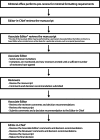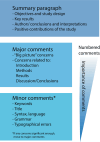How to be a good reviewer: A step-by-step guide for approaching peer review of a scientific manuscript
- PMID: 38835335
- PMCID: PMC11149763
- DOI: 10.1002/lio2.1266
How to be a good reviewer: A step-by-step guide for approaching peer review of a scientific manuscript
Abstract
Objectives: The peer review process is critical to maintaining quality, reliability, novelty, and innovation in the scientific literature. However, the teaching of scientific peer review is rarely a component of formal scientific or clinical training, and even the most experienced peer reviewers express interest in continuing education. The objective of this review article is to summarize the collective perspectives of experienced journal editors about how to be a good reviewer in a step-by-step guide that can serve as a resource for the performance of peer review of a scientific manuscript.
Methods: This is a narrative review.
Results: A review of the history and an overview of the modern-day peer review process are provided with attention to the role played by the reviewer, including important reasons for involvement in scientific peer review. The general components of a scientific peer review are described, and a model for how to structure a peer review report is provided. These concepts are also summarized in a reviewer checklist that can be used in real-time to develop and double-check one's reviewer report before submitting it.
Conclusions: Peer review is a critically important service for maintaining quality in the scientific literature. Peer review of a scientific manuscript and the associated reviewer's report should assess specific details related to the accuracy, validity, novelty, and interpretation of a study's results. We hope that this article will serve as a resource and guide for reviewers of all levels of experience in the performance of peer review of a scientific manuscript.
Keywords: checklist; editorial; guide; manuscript review; peer review; primer; research; reviewer; scientific journal; scientific review; template; tutorial.
© 2024 The Authors. Laryngoscope Investigative Otolaryngology published by Wiley Periodicals LLC on behalf of The Triological Society.
Conflict of interest statement
Ahmad R. Sedaghat is Associate Editor for Laryngoscope Investigative Otolaryngology, Rhinology and International Forum of Allergy and Rhinology; Manuel Bernal‐Sprekelsen is Editor‐in‐Chief of European Archives of Otorhinolaryngology, receives speaker honorarium from Sanofi Spain, GSK Spain, and, as scientific advisor, from Bionorica, Germany; Wytske J. Fokkens is editor‐in‐chief of Rhinology and Associate Editor for Allergy; Timothy L. Smith is editor‐in‐chief of International Forum of Allergy and Rhinology; Michael G. Stewart is former editor‐in‐chief of Laryngoscope; Romaine F. Johnson is editor‐in‐chief of Laryngoscope Investigative Otolaryngology.
Figures
References
Publication types
LinkOut - more resources
Full Text Sources



